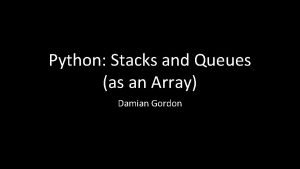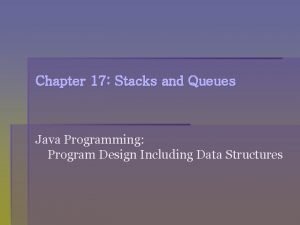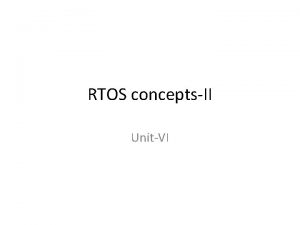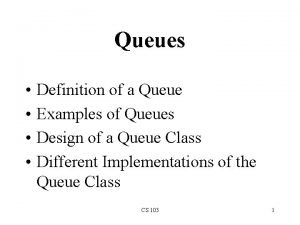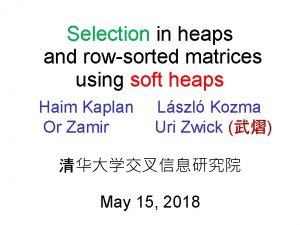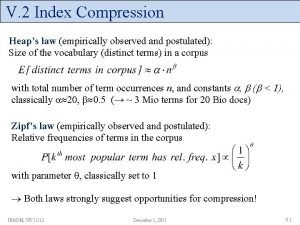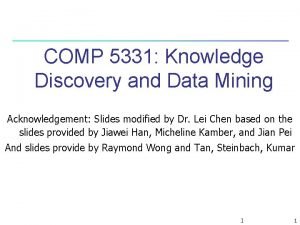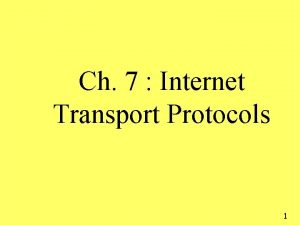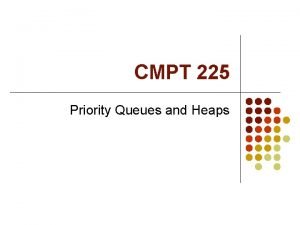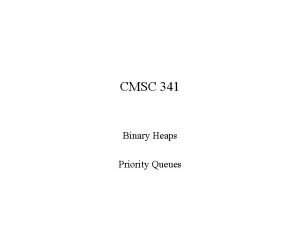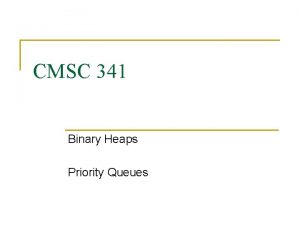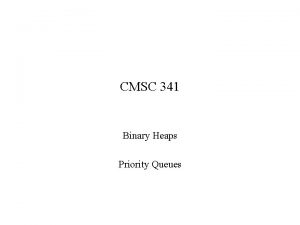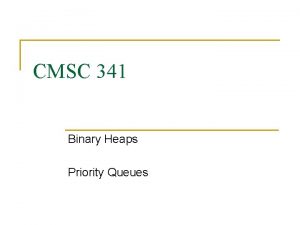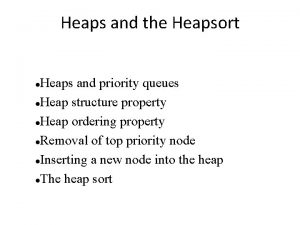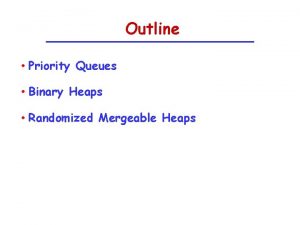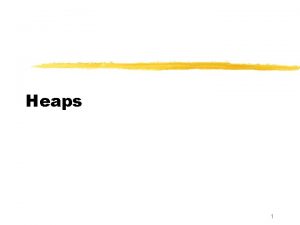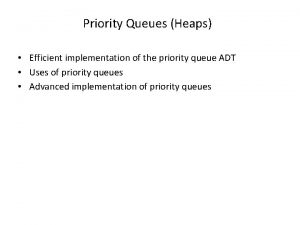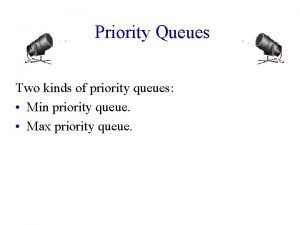CH 8 HEAPS AND PRIORITY QUEUES ACKNOWLEDGEMENT THESE




































- Slides: 36

CH 8. HEAPS AND PRIORITY QUEUES ACKNOWLEDGEMENT: THESE SLIDES ARE ADAPTED FROM SLIDES PROVIDED WITH DATA STRUCTURES AND ALGORITHMS IN C++, GOODRICH, TAMASSIA AND MOUNT (WILEY 2004) AND SLIDES FROM NANCY M. AMATO

OUTLINE AND READING • Priority. Queue ADT (Ch. 8. 1) • • Implementing a PQ with a list (Ch. 8. 2) • • Total order relation (Ch. 8. 1. 1) Comparator ADT (Ch. 8. 1. 2) Sorting with a Priority Queue (Ch. 8. 1. 5) Selection-sort and Insertion Sort (Ch. 8. 2. 2) Heaps (Ch. 8. 3) • • • Complete Binary Trees (Ch. 8. 3. 2) Implementing a PQ with a heap (Ch. 8. 3. 3) Heapsort (Ch. 8. 3. 5)

PRIORITY QUEUES • Stores a collection of elements each with an associated “key” value • • Can insert as many elements in any order Only can inspect and remove a single element – the minimum (or maximum depending) element • Applications • • • Standby Flyers Auctions Stock market

TOTAL ORDER RELATION • Keys in a priority queue can be arbitrary objects on which an order is defined, e. g. , integers • Two distinct items in a priority queue can have the same key •

COMPARATOR ADT •

PRIORITY QUEUE ADT •


LIST-BASED PRIORITY QUEUE • • 4 5 2 3 1 1 2 3 4 5

SELECTION-SORT • 4 5 2 3 1

EXERCISE SELECTION-SORT • 4 5 2 3 1

INSERTION-SORT • 1 2 3 4 5

EXERCISE INSERTION-SORT • 1 2 3 4 5

IN-PLACE INSERTION-SORT • 5 4 2 3 1 4 5 2 3 1 2 4 5 3 1 2 3 4 5

2 5 9 HEAPS 6 7

WHAT IS A HEAP? • 2 5 9 6 7 last node

HEIGHT OF A HEAP • depth keys 0 1 1 2 1

EXERCISE HEAPS • Let H be a heap with 7 distinct elements (1, 2, 3, 4, 5, 6, and 7). Is it possible that a preorder traversal visits the elements in sorted order? What about an inorder traversal or a postorder traversal? In each case, either show such a heap or prove that none exists.

INSERTION INTO A HEAP 2 5 • 9 6 z 7 insertion node 2 5 9 6 7 z 1

UPHEAP • 2 1 5 9 1 7 z 6 5 9 2 7 z 6

REMOVAL FROM A HEAP 2 5 • 9 7 6 w last node 7 5 9 w 6

DOWNHEAP • 5 7 5 9 w 7 6 9 w 6

UPDATING THE LAST NODE • The insertion node can be found by traversing a path of O(log n) nodes • Go up until a left child or the root is reached • If a left child is reached, go to the right child • Go down left until a leaf is reached • Similar algorithm for updating the last node after a removal

HEAP-SORT • •

EXERCISE HEAP-SORT •

VECTOR-BASED HEAP IMPLEMENTATION 2 • 5 6 9 0 7 2 5 6 9 7 1 2 3 4 5

PRIORITY QUEUE SUMMARY PQ-Sort total Ordered List (Insertion Sort) Unordered List (Selection Sort) Binary Heap, Vector-based Heap (Heap Sort)

MERGING TWO HEAPS 3 8 2 5 4 6 • 7 3 8 2 5 4 6 2 3 8 4 5 7 6

BOTTOM-UP HEAP CONSTRUCTION • 2 i -1 2 i+1 -1

EXAMPLE 16 15 4 25 16 12 6 5 15 4 7 23 11 12 6 20 27 7 23 20

EXAMPLE 25 16 5 15 4 15 16 11 12 6 4 25 5 27 9 23 6 12 11 20 23 9 27 20

EXAMPLE 7 8 15 16 4 25 5 6 12 11 23 9 4 5 25 20 6 15 16 27 7 8 12 11 23 9 27 20

EXAMPLE 10 4 6 15 16 5 25 7 8 12 11 23 9 27 20 4 5 6 15 16 7 25 10 8 12 11 23 9 27 20

ANALYSIS •

ADAPTABLE PRIORITY QUEUES •

LOCATION-AWARE ENTRY • Locators decouple positions and a entries in order to support efficient adaptable priority queue implementations (i. e. , in a heap) • Each position has an associated locator • Each locator stores a pointer to its position and memory for the entry g e

POSITIONS VS. LOCATORS • Position • • • represents a “place” in a data structure related to other positions in the data structure (e. g. , previous/next or parent/child) often implemented as a pointer to a node or the index of an array cell Position-based ADTs (e. g. , sequence and tree) are fundamental data storage schemes • Locator • • identifies and tracks a (key, element) item • often implemented as an object storing the item and its position in the underlying structure unrelated to other locators in the data structure Key-based ADTs (e. g. , priority queue) can be augmented with locator-based methods
 3 min quiz
3 min quiz Adaptable priority queue java
Adaptable priority queue java Applications of priority queues
Applications of priority queues Burman's priority list gives priority to
Burman's priority list gives priority to Priority mail vs priority mail express
Priority mail vs priority mail express Cqueue
Cqueue Java stacks and queues
Java stacks and queues Exercises on stacks and queues
Exercises on stacks and queues What are stacks
What are stacks Representation of queues
Representation of queues Message queues in unix
Message queues in unix Rtos mailbox
Rtos mailbox Types of queues in data structure
Types of queues in data structure Examples of queue
Examples of queue Mgh
Mgh Soft heaps of kaplan and zwick uses
Soft heaps of kaplan and zwick uses Love heaps
Love heaps Lazy binomial heaps
Lazy binomial heaps Skew heap
Skew heap Heap or pile - they are puffy
Heap or pile - they are puffy Geetika tewari
Geetika tewari Heaps cs
Heaps cs Tom heaps
Tom heaps Heap's law
Heap's law Introduction and acknowledgement
Introduction and acknowledgement Slide-seq
Slide-seq Technical background example
Technical background example Acknowledgement in ppt
Acknowledgement in ppt Acknowledgement presentation
Acknowledgement presentation Dont reply all
Dont reply all Acknowledgement in presentation
Acknowledgement in presentation Acknowledgement slide
Acknowledgement slide Tcp reno vs tahoe
Tcp reno vs tahoe Acknowledgement slide
Acknowledgement slide Acknowledgement for english project
Acknowledgement for english project Acknowledgement in presentation
Acknowledgement in presentation Western sydney uni library
Western sydney uni library





